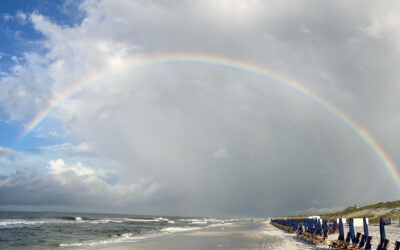rise of the vacation home rental
Last year, a record number of American travelers experimented with their lodging options. They fell in love with one in particular...

The vacation home rental market. Not only is it the newest player in the lodging space, it’s also widely recognized as the most dynamic and innovative. And since the beginning of the COVID-19 pandemic in the spring of 2020, it has enjoyed an unexpected surge in popularity.
Its appeal?
The incredible variety of homes, say many industry observers. Also, their inherent safety in an age of pandemic.
“It’s been a remarkable turn of events,” says Jake McClendon, Senior Vice President of Growth and Client Services for 360 Blue. “The phenomenon that initially threatened the entire travel industry became a huge driver of demand in the vacation rental space.”
“Two years ago guests really wanted to vacation alone with trusted friends and families,” says Mike Perkins, Senior Vice President of Operations for 360 Blue. “They also wanted to have control over who they came in contact with. The vacation home rental checked both of those boxes. Now their eyes have been opened to what the VR experience is all about.”
This surge in demand, however, isn’t exclusive to the Emerald Coast. Natural Retreats, which manages luxury properties in 17 destinations throughout the United States, has felt the love nationwide.
“Vacation home rentals are finding a whole new audience these days as folks shy away from crowded spaces,” says Chris Holden, CEO of Natural Retreats, the parent company of 360 Blue. “In the last two-plus years, millions of Americans have tried them for the first time—and they’ve fallen in love with the experience.”
“In the last two-plus years, millions of Americans have
tried them for the first time—and they’ve fallen in love
with the experience.”
— Chris Holden, CEO of Natural Retreats
WHAT’S OLD IS NEW AGAIN
The vacation home rental concept stretches back centuries to a time when extended stays were common among the affluent and their preferred lodging was a home over a hotel. Availability and rates were disseminated by word-of-mouth, newspaper adverts and mail service, and an agreement was arrived at between guests and the owner. The arrangement worked for both parties. The homeowners enjoyed additional revenue while their guests experienced a destination in a far more intimate way than any hotel could offer.
The first vacation rental listings appeared in American newspapers in the 1950s. What followed was the slow, organic growth of an ever- evolving lodging category. Most of these vacation homes were looked after by professional property managers charged with overseeing not only the care, but the marketing of the homes in their portfolio. Some, however, were managed by the owners who would maintain and clean them between stays and market them in various newspapers.
The trend industry-wide, however, has always been toward the “professionalization” of the vacation rental space, with property management companies delivering evermore sophisticated levels of services to both homeowners and guests.
The trend would help yield solid, steady growth over the years. It would also position the industry up for what came next. In the mid-1990s, along came the internet. From that moment forward, the vacation rental market would never again be the same.
The inventory of vacation rental homes expanded worldwide!

A BRAVE NEW WORLD
This new era would introduce the world to the online travel agency, or OTA. Vacation Rental by Owner (VRBO) launched in 1995 and is widely considered the first platform of its kind in the vacation rental space that electronically connected
homeowners with guests. Home listings included photos and detailed property information, along with availability and rates.
Since then, innovation and authenticity have been the industry’s watchwords.
Perhaps the most creative example of this was a company called Couchsurfing International which connected travelers looking for a brief stay with homeowners who were willing to let them camp out on their sofa for a few nights. The homeowner got to meet out-of-towners. The traveler got to connect with an actual local who could offer them the thing they prized above all else—local knowledge. The homeowner knew the best pub, the public transit schedule, the must-see stops that didn’t show up in guidebooks.
Couchsurfing aside, mainstream companies would be the change agents throughout the broader industry. And dizzying change was on the way.
The year 2005 saw the launch of HomeAway, an OTA formed through the merger of several vacation rental sites that would acquire VRBO the following year. In 2008, a small San Francisco startup called Airbnb launched to little fanfare. Seven years later, in 2015, Expedia purchased HomeAway, the parent company of VRBO, further setting the stage for the mainstreaming of the vacation rental sector.
Meanwhile, the inventory of vacation rental homes was expanding worldwide.
“Today’s vacation rental home market offers homes with every feature and amenity you can imagine,” says Trisha Severs, Project Manager for 360 Blue. “And they offer them in nearly every destination on the planet, giving travelers access to accommodations that truly resonate with them— whether they’re traveling for business, a traditional family vacation, or a special occasion.”
Yet the vacation rental market was but a small fraction of the size of the hotel market. However, its popularity was about to skyrocket under the most challenging circumstances imaginable.
ALONG CAME COVID-19
In the spring of 2020, commercial airline flights were being canceled by the thousands and cruise ships were called back to port, some even mothballed. Many hotels remained open but mostly empty as bookings dried up. On March 16, 2020, Disney World closed. Meanwhile, travel bans between states proved a near-death experience for many in the travel space—including the vacation home rental market.
Domestic travel restrictions had eased by late spring, however, and Americans were primed to hit the road. But they were planning a very different vacation than they had in the past—though few in the industry recognized the nature and scope of what was happening.
Travelers were no longer interested in just the traditional week away. Instead, they were experimenting with what was possible under a set of radically different circumstances. And technology offered a whole new world of possibilities. Teleconferencing, for instance, was now commonplace and trusted. For many families, it was an ah-ha moment.
“People were booking vacations well into the fall of 2020 because they could suddenly work from home,” says Aliza Fogarty, Director of Guest Services at 360 Blue. “They could take their families with them because their children were taking classes online.”
Guests were discovering that they now had the ability to book a home that had everything they needed for an extended time away—for a “flex- cation” or a “staycation.” Teleconferencing paired with the vacation home rental made the extended hybrid vacation not only doable but incredibly safe. And the variety of expansive vacation homes available made it comfortable and attractive to an entire family.
“Guests were looking for a vacation experience they could customize to the needs of their family”

“Since the onset of the pandemic, we’ve seen a significant increase in interest from people looking for safe, remote, and exciting rental properties,” says Jerry Hefner, VP of Marketing for Natural Retreats. “These have not only included short-term vacation rentals for our families and friends but also long-term rentals for those looking for a change of pace while working remotely or attending virtual education programs.”
“Our guests were looking for a vacation experience they could customize to the needs of their family— from specialty services to rental equipment delivered prior to arrival,” says Severs. “They also want to know the details—which homes have the best porches, the best views, and kitchens.”
By the spring of 2021 the surge in travel hadn’t let up. If anything, it had only increased with record- breaking summer bookings. The appeal also seemed to be diversifying.
“Across the industry we saw guests choose vacation home rentals in the summer of 2020 for safety considerations,” says Nathan Henris, Vice President of Marketing for 360 Blue. “But for those that were previously new to vacation rentals, the appeal has since expanded to lifestyle preferences such as in- home amenities and location. Guests know the safety advantages of vacation homes and enjoy the feeling of being ‘at home.’ And we’ve adjusted our messaging to reflect this change in awareness.”
The sustained demand was something of a surprise for several reasons, not least of which was the fact that the pandemic wasn’t really “over.” The Delta variant would make this all too clear, infecting millions of Americans in the late summer and early fall of 2021. Then came the Omicron variant. Through it all—after the endless highs and lows— the vacation home rental would emerge as the lodging option of choice for millions of travelers.
THE ROAD AHEAD
So what does the future look like for the vacation home rental space? Does the recent surge in demand have staying power?
“Our thinking is that the pendulum will likely swing back somewhat,” says McClendon. “Not necessarily to pre-pandemic levels of demand, but back to something more in line with historical trends. With this in mind, we’re doing two things at
once: taking advantage of the current surge while preparing for a potential return to normalcy.”
Meanwhile, property managers and homeowners continue to adapt and innovate to meet the moment.
“It’s been amazing to see the reaction from our homeowners to accommodate working remotely,” says Douglas Burns, COO/CFO of Natural Retreats. “They understand the benefits to them and our guests of investing in workspaces and reliable internet that allow people to have a dedicated, professional—yet comfortable—place to connect.”
Many see the pandemic as a gateway event that will continue to define travel habits long after the COVID-19 threat has subsided. One key change: They will continue to prefer vacation home rentals for everything they offer.
“The pandemic introduced a lot of Americans to the vacation home rental concept,” says Perkins. “Did we do enough as a company and as an industry to keep them coming back? Did we do enough to make them repeat guests? I think we absolutely crushed it.”
“It’s been amazing to see the reaction from our homeowners to accommodate
working remotely, they understand the benefits to them and our guests…”
— Douglas Burns, COO/CFO of Natural Retreats
Recent Stories
Explore and discover all of the Emerald coast.
Sandcastle Kids: Healing Hearts
Sandcastle Kids, a South Walton 501c3 nonprofit, carries out their healing mission by providing all-expenses-paid vacations to families experiencing a diagnosis of childhood cancer. As you can imagine, these families undergo tremendous mental, emotional, and financial...
The Secret History of Eastern Choctawhatchee Bay
There’s an odd cluster of pilings on the eastern edge of the Choctawhatchee Bay. Ever noticed them when driving north across the bridge? These aren’t the remains of an ill-fated attempt at a bridge, but are part of a system capable of detecting low-flying aircraft...
Serving in Seaside for 23 Years and Counting
Bartender Mo Mosely has been greeting patrons and slinging drinks at Bud and Alley’s rooftop bar for 23 years (and counting). Back before Scenic 30A was the bustling, year-round destination that it is today, Bud and Alley’s was the only bar on 30A open late into the...



